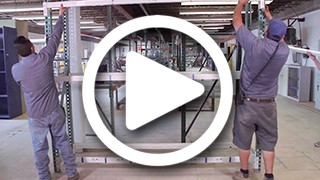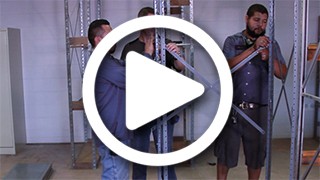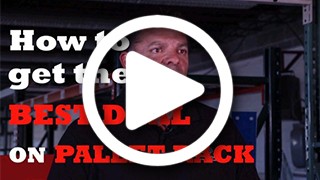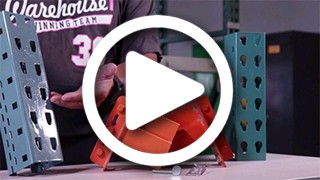How to Choose a Racking System for Your Warehouse
Warehousing solutions have taken a huge leap forward in recent years, spurred by exciting technological advances. Still, the basis of these facilities remains the same as ever: effective pallet racking is non-negotiable.
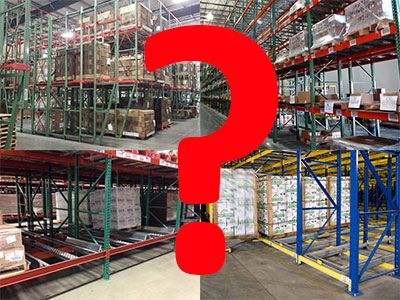 Think of pallet racks as the framework of your entire facility: this is how you determine where specific types of products are stored, how they will be picked, and which types of equipment or personnel will be involved in these processes.
Think of pallet racks as the framework of your entire facility: this is how you determine where specific types of products are stored, how they will be picked, and which types of equipment or personnel will be involved in these processes.
These factors, in turn, will determine whether you're able to maximize your space. The right solution will set you up for success in a rapidly evolving and increasingly competitive market — and the wrong approach will hamper everything from efficiency to accuracy and even worker safety.
With so much at stake, it's no wonder this decision feels so overwhelming. A little insight can make a world of difference, so we've highlighted some of the most important considerations to keep in mind as you choose the right racking system for your facility.
Remember: there's no one right solution for every situation — but certain racking strategies consistently produce stellar results. Keep reading to learn which factors guide these decisions — and which warehouse pallet racking solutions are most impactful.
Considerations When Choosing a Racking System
As you begin to explore the various types of storage racks, consider where your priorities lie and which constraints you face. No racking system will meet the needs of every enterprise, so you'll want to have a solid grasp of what, exactly, you hope to accomplish and how certain types of racking can help you achieve these goals.
For many businesses, at least a few of the following considerations will come into play:
- Available space
- Weight and size of the items being stored
- Accessibility needs
- Durability
- Cost
The scope of this may seem vast, but remember: not all of these factors are necessarily pain points for your business. Below, we'll take a closer look at how these considerations could play out in your facility — and how you'll know if they should be a priority.
Available Space
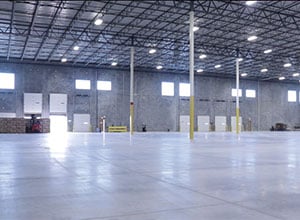 In the ideal world, you would have more than enough warehouse space to easily handle a vast inventory without incurring significant expenses. In the real world, however, you need to make the most of every square foot while also keeping operational expenses to a minimum.
In the ideal world, you would have more than enough warehouse space to easily handle a vast inventory without incurring significant expenses. In the real world, however, you need to make the most of every square foot while also keeping operational expenses to a minimum.
No matter which form it takes, pallet racking moves you towards this goal, as it harnesses the power of vertical space. Some pallet storage systems, however, allow for far higher volumes than others.
Weight and Item Size
The types of items stored have a huge impact on racking decisions, as some structures are simply ill-equipped to handle heavy or bulky products. Selective racking is preferred by most, but some solutions are specifically designed to accommodate larger or unique items.
Cantilever racks, for example, provide durable and flexible storage for unusually shaped objects. Regardless of the preferred racking type, it's important to take a close look at the capacity in terms of pallet position, as well as the weight and other dimensions of any given racking product.
Accessibility
Some warehouse operations call for maximum accessibility, while others have a bit of leeway in this regard. Often, racking systems have an inverse relationship between accessibility and storage density: the higher the volume, the more difficult it will be to access items. There are exceptions, of course, with dynamic racking solutions enhancing both selectivity and volume.
Accessibility largely depends on how deep the pallets are stored and which type of configuration is utilized. Key approaches include:
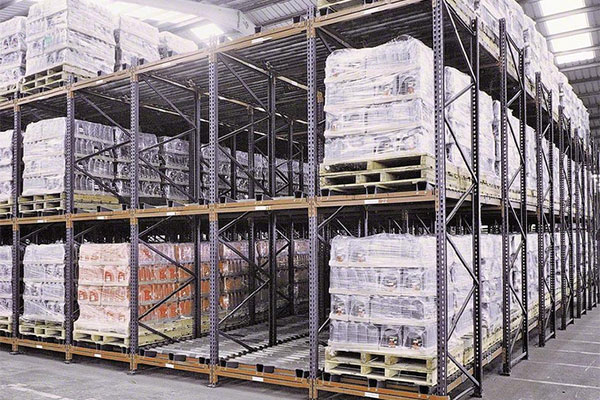 First in, first out. Placing the loading and unloading areas on opposite sides, FIFO solutions allow for streamlined warehouse operations and improved quality control. If implemented properly, this can be a great option for limiting labor costs. Pallet flow is one of the most common FIFO setups, although drive-through racks also qualify for this category.
First in, first out. Placing the loading and unloading areas on opposite sides, FIFO solutions allow for streamlined warehouse operations and improved quality control. If implemented properly, this can be a great option for limiting labor costs. Pallet flow is one of the most common FIFO setups, although drive-through racks also qualify for this category.- Last in, first out. High-volume applications often involve LIFO setups, in which the most recently placed items are removed first. Ideally, items stored under this system will have a long shelf life and a limited need for stock rotations. Double-deep, drive-in, and push-back pallet racks can all be configured in this manner.
Durability
As we've already discussed, durability should be a key factor when optimizing storage for heavy items. Even if this consideration isn't relevant, durability is always important. In high-traffic warehouse settings, racking systems must hold up to heavy use.
Supposedly affordable solutions won't feel like such a good deal if they're clearly prone to damage. Materials matter, of course, but the very structure of these racks will also determine how durable they ultimately are.
Be sure to consider the presence of forklifts, as these tend to cause the bulk of wear and tear to racking systems. For this reason, drive-in and drive-through solutions need to be especially durable.
Cost
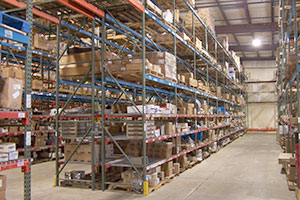 The cost of implementation can be high, even for the most affordable pallet racking systems. This is a crucial investment, of course, but immediate expenses must be taken into account when dealing with limited financial resources. In general, simpler structures tend to cost less at the outset, although these may produce a lower ROI if they're unable to create sufficient storage density.
The cost of implementation can be high, even for the most affordable pallet racking systems. This is a crucial investment, of course, but immediate expenses must be taken into account when dealing with limited financial resources. In general, simpler structures tend to cost less at the outset, although these may produce a lower ROI if they're unable to create sufficient storage density.
As we'll discuss later, selective racking is a go-to option for businesses that desperately need to cut costs. In other situations, however, it may be more beneficial to select a dynamic solution and then invest in used pallet racks. Assuming they're sufficiently durable, these can provide significant savings without any major downsides in terms of storage volume, agility, or access.
Fabrication methods are also highly impactful. The two main categories include roll-formed and structural. Roll-formed racks are nearly always more affordable to produce, although their structural counterparts are better-suited to heavy-duty applications.
Types of Warehouse Racking Systems
With so many factors at play, you might begin to wonder: will any types of pallet racking actually make the cut? Thankfully, there are several excellent solutions that live up to your most stringent demands. Top options include:
Selective Racking
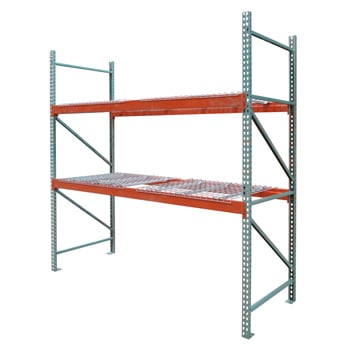 Providing immediate access to each and every pallet position, selective pallet racking typically involves simple rows placed back-to-back. These are separated by access aisles, which, as this category's name implies, maximize selectivity.
Providing immediate access to each and every pallet position, selective pallet racking typically involves simple rows placed back-to-back. These are separated by access aisles, which, as this category's name implies, maximize selectivity.
The obvious appeal of selective racking lies in its low cost. This is by far the least expensive approach, especially as compared to the advanced solutions we'll describe below. Unfortunately, this low cost is accompanied by a low storage capacity, making this a less-than-desirable option when dealing with small spaces or high volumes.
Double-Deep Racking
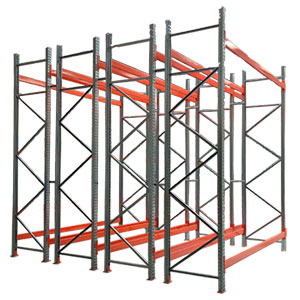 Delivering significant improvements in storage capacity as compared to selective racking, double-deep solutions can work wonderfully for spaces with significant volume requirements and limited or moderate turnover. This solution simultaneously produces higher capacity and reduced selectivity. These two-pallet deep racks are typically placed back-to-back with other two-pallet rows, making it possible to double storage space while reducing the number of aisles.
Delivering significant improvements in storage capacity as compared to selective racking, double-deep solutions can work wonderfully for spaces with significant volume requirements and limited or moderate turnover. This solution simultaneously produces higher capacity and reduced selectivity. These two-pallet deep racks are typically placed back-to-back with other two-pallet rows, making it possible to double storage space while reducing the number of aisles.
In the wrong facility, double-deep solutions can be disastrous. Their main disadvantage lies in the very structure that makes them so appealing for high-density spaces: the placement of inventory behind other pallets means that access to SKUs will be inherently limited. What's more, specialized forklifts may be required. As with selective racking, however, this can be a uniquely affordable solution to implement and is usually easy to maintain.
Push-Back Racking
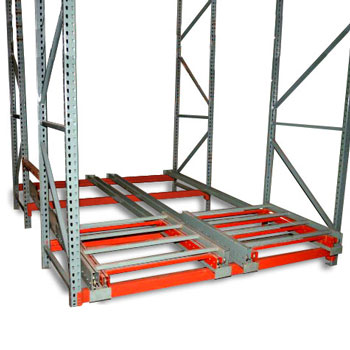 As a moderate to high-density storage solution, push-back racking provides the best of both worlds: impressive volume alongside enhanced selectivity. Pallets can be stored two, three, or even four (or more!) deep, but retrieval can be optimized with strategic shuttles or rollers.
As a moderate to high-density storage solution, push-back racking provides the best of both worlds: impressive volume alongside enhanced selectivity. Pallets can be stored two, three, or even four (or more!) deep, but retrieval can be optimized with strategic shuttles or rollers.
A single aisle can be used to both load and retrieve items, making this a compelling option when space is limited. These racks are less susceptible to damage than other systems, due to limited interference from forklifts. As a result, maintenance needs may be minimal, despite their seemingly more intricate structure.
At first glance, this approach appears to be the best option across many types of facilities. There are situations, however, in which push-back systems should be avoided. Versatility may be limited for these structures — and the unique distribution style may not be ideal for certain time or date-sensitive applications. These dynamic solutions also tend to be more expensive to implement, although they may ultimately produce an impressive return on investment.
Drive-In/Drive-Through Racking
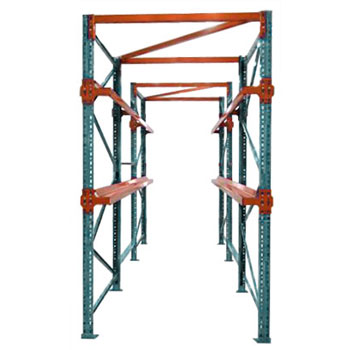 When elite storage capacity is required, there are few strategies more desirable than drive-in or drive-through racking systems. These solutions limit the need for aisles, thereby freeing up significant floor space. Drive-in racks center around a last in, first out principle that enables loading and retrieving on the same side.
When elite storage capacity is required, there are few strategies more desirable than drive-in or drive-through racking systems. These solutions limit the need for aisles, thereby freeing up significant floor space. Drive-in racks center around a last in, first out principle that enables loading and retrieving on the same side.
Drive-through systems are structured similarly but place loading and unloading processes on separate sides of these structures. This produces a first in, first out method of retrieval that can promote greater efficiency. These drive-through structures may also be referred to as double-entry racking systems.
Under both setups, the forklift actually enters the racking system to improve ease of access. With greater exposure to forklifts, however, comes an increased potential for damage. Thankfully, these systems are highly durable, so they can stand up to forklifts and other forms of wear and tear.
Another noteworthy advantage? This approach is highly scalable, with upgrades uniquely easy to implement as needed. If you require a cost-effective solution but hope to eventually make improvements to your racking setup, a drive-in or drive-through system may be your best bet.
Pallet Flow Racking
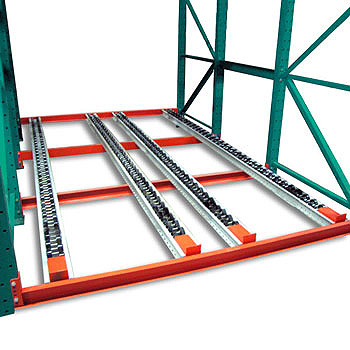 Making the most of gravity through the targeted use of rollers, pallet flow racking holds many similarities to a typical conveyor belt: pallets are loaded at the rear and eventually make their way to the front. This produces a first in, first out method that enables the consistent movement of inventory. Few aisles are needed, so the space savings can be considerable.
Making the most of gravity through the targeted use of rollers, pallet flow racking holds many similarities to a typical conveyor belt: pallets are loaded at the rear and eventually make their way to the front. This produces a first in, first out method that enables the consistent movement of inventory. Few aisles are needed, so the space savings can be considerable.
Pallet flow solutions share (and may amplify) many of the downsides of push-back racking: they're not particularly flexible and can be expensive to implement. Despite this, pallet flow racking remains the go-to solution for storing date-sensitive items. Carton flow racks are similar in that they utilize gravity to great effect.
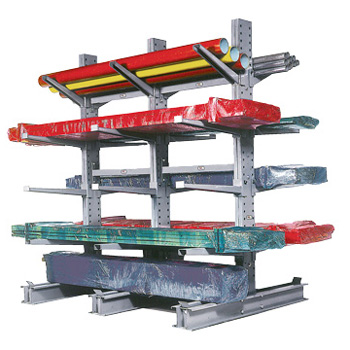 Cantilever Racking
Cantilever Racking
Ideal for bulky or awkwardly-shaped items, cantilever racking consists of upright columns, horizontal braces, and arms that keep products secure. This approach is far costlier than selective racking but may be unavoidable for certain types of products. Cantilever racks are often surprisingly easy to load and unload with forklifts, even as compared to selective systems.
Pallet Racking Accessories
When choosing a racking system, it's important to take a close look at accessories to enhance the benefits and life of your investment. Wire decking, for example, enables open-case storage while limiting the damage from falling items. Accessories such as column guards and end-of-aisle guards protect your rack from forklift damage, avoiding the costs involved with repairing or replacing parts of your system.
Find the Perfect Warehouse Storage Solution
Struggling to choose the ideal storage system for your warehouse? Our team at Warehouse1 can point you in the right direction. Whether you require exceptional storage capacity or an unmatched throughput, we can quickly determine which approach meets your unique material handling needs. We’ll help you find automation opportunities and other creative solutions that can dramatically improve your ROI. Contact us today to learn more.
